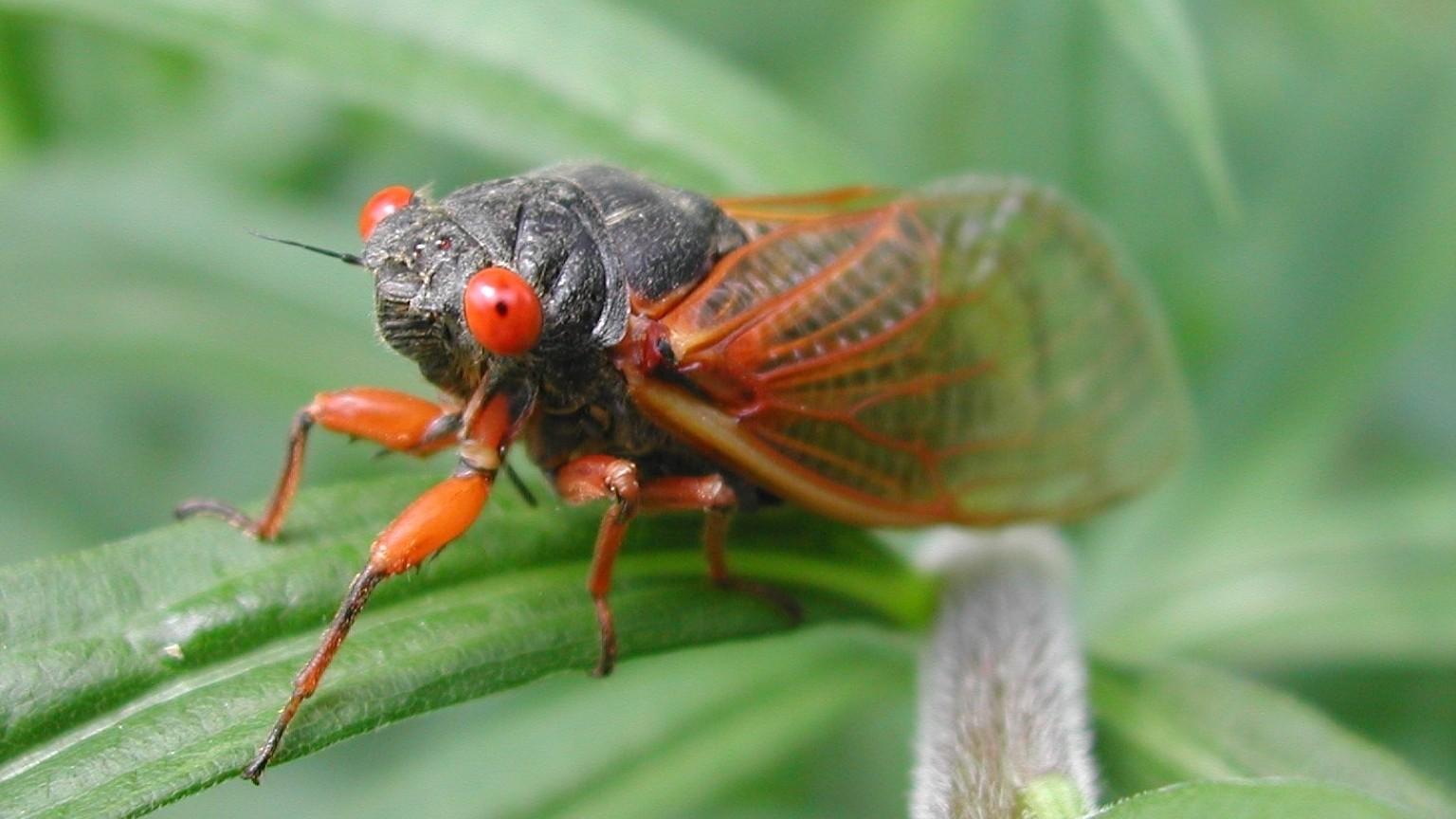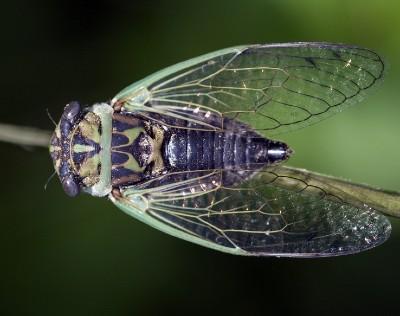
Periodical cicada (Magicicada sp.). Photo: Pennsylvania Department of Conservation and Natural Resources - Forestry , Bugwood.org
Key points about cicadas
- Cicadas are large charismatic insects in the order Hemiptera. They have sucking mouthparts which they use to feed from the xylem (water and mineral transporting tissue) of trees and shrubs.
- There are two types of cicadas commonly found in the eastern United States:
- The dog-day or annual cicadas, Neotibicen spp., emerge every summer (June through August).
- Periodical cicadas, Magicicada spp., emerge every 13 or 17 years, depending on the species. In Maryland, the 13-year Brood XIX is predicted to emerge in spring 2024 in southern areas of St. Mary’s County.
- Cicada nymphs (immatures) live underground and emerge from the soil during the spring or summer. After molting into adults, individuals move or fly to nearby vertical structures, especially shrubs and trees. Males will start their droning mating song to attract females. This is accomplished by vibrating membranes (tymbals) located on the sides of the insect beneath the wings.
Appearance and life cycle of cicadas
- Adults vary in size and color according to species. All have prominent bulging eyes, a straw-like mouthpart (proboscis), and semi-transparent wings held roof-like over their large bodies.
- Adult dog-day cicadas are about one and one-half to two inches long with brown or green, black and white body markings.
- Adult periodical cicadas are slightly smaller, with black bodies, reddish-brown eyes, and orange wing veins. Their wings will have a black ‘W’ marking on the front wings.
- A week after they emerge, the adult cicadas will mate and the females deposit eggs in batches of 20-30 eggs within pencil-thin branches of more than 200 kinds of woody plants.
- The eggs hatch in about six weeks.
- The young or nymphs drop to the ground where they burrow into the soil and feed on the sap of tree roots. Nymphs resemble wingless adults, have --tan-brown stout bodies, and have strong front legs specialized for digging and tunneling in the soil. They undergo four molts (growth spurts) while underground.
- For the dog-day cicada, this will take 2-5 years. This species has overlapping generations that are not synchronized.
- For the periodical cicada, this will take 13 or 17 years, depending on the species. These cicadas emerge in large numbers known as broods. Broods II, V, X, XIV, and XIX are found in Maryland. Brood II (17-year) emerged in 2013 and will emerge again in 2030. Brood X (17-year) emerged in Maryland in 2021 and will emerge again in 2038. Brood XIX (13-year) will emerge in southern St. Mary’s County in 2024. A few periodical cicadas (“stragglers”) emerge a year ahead or behind the rest of its Brood.
- During an emergence, mature cicada nymphs will tunnel to the soil surface and crawl out of dime-sized holes. Then they will climb onto tree trunks, posts, and other upright structures. After a short period of time the nymphs molt or shed their “skin” (exoskeleton) to become winged adults. The empty exoskeletons are left clinging to objects.

Emerging cicada. Photo: Joseph OBrien, USDA Forest Service, Bugwood.org

Cicada nymph: Photo: Paula Shrewsbury, Ph.D., University of Maryland

Annual or dog-day cicada adult. Photo: David Cappaert, Bugwood.org
Damage
-
The only damage cicadas cause to plants results from the egg laying habits. Female cicadas use an appendage, called an ovipositor, to gouge longitudinal slits in twigs into which they then deposit eggs. The ovipositor cannot harm people. Adults do not feed on leaves. If they feed at all, it is by sucking plant fluid from tender young twigs.
-
Cicadas pose no health threat to people or pets, although consumption of large numbers by pets should be discouraged.

Periodical cicada female laying eggs into stem. Photo: Pennsylvania Department of Conservation and Natural Resources - Forestry, Bugwood.org

Egg laying damage to a tree twig. Photo: Jim Baker, North Carolina State University, Bugwood.org
-
Twigs with many slits often break or hang down from the tree, a condition known as flagging. This damage is not serious. The trees will easily replace branches that have been broken or “pruned” by cicadas.
-
Young or newly planted trees may be killed, or their growth stunted if this type of injury is extensive during brood years. These plants may be protected by covering them with netting or a breathable fabric (see Management below).
-
Cicadas have been known to lay eggs on over 200 types of trees to some extent. Some common trees that are most susceptible to cicada damage include oaks (Quercus), maples (Acer), cherry (Prunus), and other fruit trees, hawthorn (Crataegus), and redbud (Cercis).

Tree branches damaged by cicada egg laying. Photo: Jim Occi, BugPics, Bugwood.org

Flagging damage on maple tree. Photo: David L. Clement, University of Maryland
-
When large numbers of nymphs emerge from the soil, exit holes may be noticeable in a lawn. Several weeks before emergence, some nymphs construct mud chimneys over the emergence hole. These mounds may be 2-3 inches high and 1-2 inches wide with a hole approximately 1/2 inch wide in the center. The activity may be unsightly but does not permanently harm the turf.

Cicada emergence holes. Photo: M.K. Malinoski, University of Maryland Extension
Management
-
Control is not necessary on established mature trees.
-
Insecticides are ineffective for significantly reducing cicada abundance and damage. Insecticides also pose a risk to people, pets, beneficial insects, and birds.
-
If you intend to plant trees or shrubs in a year when periodical cicadas emerge, consider delaying planting until fall when the cicadas are gone.
-
Small ornamental trees, shrubs, and fruit trees may be protected by covering them with insect netting sold in garden centers, nurseries, and online. It was observed in 2004 that insect netting with openings ranging from 1/4-in. to 3/8-in. (0.6-cm. to 1.0 cm.) prevented injury to small trees. Bird netting openings are too large to exclude cicadas. Tulle and other breathable fabrics are available that can be draped over small or newly planted trees and shrubs and held to the ground with rocks, bricks, or landscape pins or secured to the base of the trunk to prevent cicadas and wildlife from becoming trapped. The plants should be protected from the time cicadas emerge until they are gone 6-8 weeks later. If left on too long, barriers may physically impede new foliage/stem growth, reduce air circulation (which can promote fungal infection), and shade leaves which will later become sunburned when their full-sun exposure is resumed. Barriers may also prevent pollination, depending on plant flowering times.

Netted young tree
Photo: M.J. Raupp - Cicadas do not target herbaceous plants (annuals and perennials, including vegetables and herbs) for feeding or egg-laying. They may climb onto them for support but won't harm them.
- Organic mulches spread around garden and landscape plants, up to a 3-in. depth, will not interfere with the cicada life cycle.
- Ornamental ponds should be covered with screening or plastic mesh to prevent cicadas from accumulating. Large numbers of decomposing cicadas could cause problems with oxygen depletion in the water.
- Clean pool skimmers/filters frequently during cicada emergence to keep them from getting clogged.
Common questions about periodical cicadas
Where are periodical cicadas found in North America?
Periodical cicadas are found in eastern North America. Periodical cicada emergences are geographically distinct; the ones that emerge in the same area and year (13- or 17-year cycles) are known as a brood. Broods II, V, X, XIV, and XIX are found in Maryland, with Brood X having the largest range and concentration of any of the broods.
How long will periodical cicadas be out?
Adult periodical cicadas live between 2 and 6 weeks after they emerge from the ground. Adults will begin emerging around April and will last through mid-June.
How are periodical cicadas different from the cicadas I see every summer?
Periodical cicadas are smaller and have much more red-orange coloring than the common, large, green “dog day” cicada (genus Neotibicen) we see and hear later every summer. Dog-day cicadas are not periodical. Although their life cycle is typically 2-5 years long, some emerge every summer since their generations overlap.
How many cicadas do we expect to see this year (2024)?
Cicada emergence density can be as high as 1 million per acre. (An acre is a little smaller than a football field!) However, how many we will see this year in southern St. Mary’s County depends greatly on the amount of urbanization, deforestation, or fire that has occurred within the last 13 years.
Will periodical cicadas eat or damage my flowers, shrubs, or trees?
Periodical cicadas do not damage flowers, but they may damage newly planted or young trees and some shrubs. Damage results from female cicadas laying eggs in small twigs and branches (resulting in small slits), not from adult feeding.
Do cicadas bite or sting?
No. Cicadas do not sting like wasps and bees. Female cicadas have an organ called an ovipositor that they use just for laying eggs in twigs. Adult cicadas may make a loud buzzing sound if handled but cannot bite or sting.
Why do periodical cicada broods only emerge in 13 or 17 year cycles?
This is still somewhat of a mystery. There are several hypotheses for this, centered around reducing their vulnerability to predators. In order to overwhelm their predators with high numbers and survive to reproduce (predator satiation), periodical cicadas must emerge at the same time. Mathematically, 13 and 17 year brood emergences only overlap once every 221 years! This prevents hybridization between broods -- which could interfere with the timing of their emergence, reducing populations and making them much more susceptible to extirpation by predators.
Additional resources
Double Cicada Mania Approaches—But Seeing Them Calls for a Road Trip | Maryland Today (April 4, 2024)
Sorry DC and Baltimore, no Periodical Cicadas for You this Year, Unless you Take a Road Trip: Brood XIII (13) and Brood XIX (19), Magicicada spp. | Dr. Michael Raupp, University of Maryland
UMD Entomology Department Set to Study Rare Cicada Emergence | The Diamondback, University of Maryland
The 2024 Periodical Cicada Emergence | University of Connecticut
Cidada Crew UMD | FAQs, information, and resources on periodical cicadas and specifically Brood X from the University of Maryland Entomology Department
Cicada Safari | Community Science- mapping periodical cicada emergences
Adapted from publication HG 43 Periodical Cicadas, Authors: M.R. Raupp, F.E. Wood, J.A. Davidsion, & J.L. Hellmans, Department of Entomology, University of Maryland. Revised: H. Menninger, & S. Frank, Dept. of Biology & Entomology, University of Maryland. Updated by Emily Zobel (2020) and Madeline Potter (2024), University of Maryland Extension.
Still have a question? Contact us at Ask Extension.